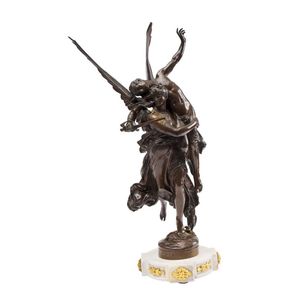"Gloria Victis" Bronze Figural Sculpture
You must be a subscriber, and be logged in to view price and dealer details.
Subscribe Now to view actual auction price for this item
When you subscribe, you have the option of setting the currency in which to display prices to $Au, $US, $NZ or Stg.
- Circa - A Latin term meaning 'about', often used in the antique trade to give an approximate date for the piece, usually considered to be five years on either side of the circa year. Thus, circa 1900 means the piece was made about 1900, probably between 1895 and 1905. The expression is sometimes abbreviated to c.1900.
- Ormolu - Ormolu was popular with French craftsmen in the 18th and 19th century for ornamental fittings for furniture, clocks and other decorative items. True ormolu is gilt bronze, that is bronze that has been coated with gold using a mercury amalgam. Due to the health risks associated with using mercury, this method of creating ormolu was discontinued in France in the 1830s. A substitute was developed consisting of about 75% copper and 25% zinc, however it was inferior to the bronze version. It was often lacquered to prevent it tarnishing.
- Bronze - An alloy of copper and tin, traditionally in the proportions of about 9 parts of copper to 1 part of tin.
The discovery of bronze in Western Asia in the 4th century enabled people to create metal objects which were superior to those previoulsy possible because of its strength and hardness, and it has been used throughout the world for weapons, coins, tools, statuary and other decorative items.
It is very fluid in a molten state, and its hardness, strength when set, and non-corrosive properties makes it most suitable for casting sculpture.
This item has been included into following indexes:
Visually similar items

A French bronze figure of Fortuna, cast, after a model by Louis Guillaume Fulconis (1817-1873), late 19th century. Cast in typical pose, inscribed on the base 'Fulconis' on a black marble and relief cast bronze socle, 75 cm high

A Victorian bronze of the Greek god Hermes, or the Roman god Mercury (the Winged Messenger), his left foot balancing on a column of air, which is fed by the mouth of Zephyr, bronze and marble base, after the original by Jean De Bologne, lacking caduceus. H

A life size, bronze Ganesha, dancing on a lotus base, south India, possibly late Chola period, the face flanked by wide ears & his hair in a high conical shaped chignon held back by a jewelled crown, with four arms, each of the hands in a gesture of hasta,

Adrien Etienne Gaudez (1845-1902), 'Acteon', bronze sculpture, the semiclothed figure wearing a lion skin wrap, horn to his left hand, lance to his right. Attention required to lance end. Signature moulded to base. Height 56 cm
